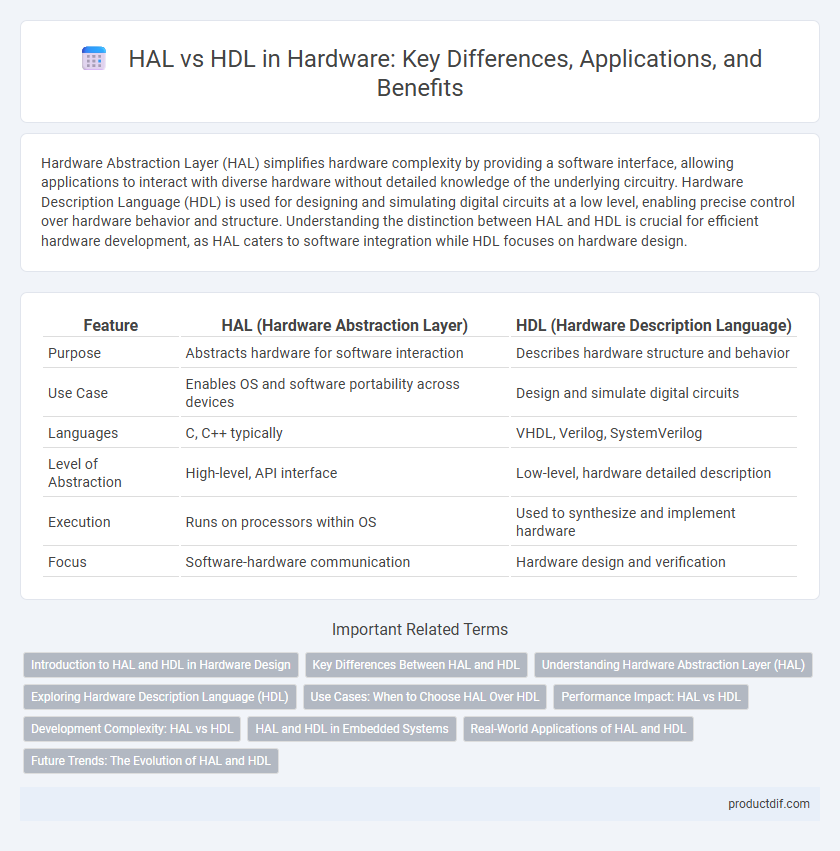Hardware Abstraction Layer (HAL) simplifies hardware complexity by providing a software interface, allowing applications to interact with diverse hardware without detailed knowledge of the underlying circuitry. Hardware Description Language (HDL) is used for designing and simulating digital circuits at a low level, enabling precise control over hardware behavior and structure. Understanding the distinction between HAL and HDL is crucial for efficient hardware development, as HAL caters to software integration while HDL focuses on hardware design.
Table of Comparison
| Feature | HAL (Hardware Abstraction Layer) | HDL (Hardware Description Language) |
|---|---|---|
| Purpose | Abstracts hardware for software interaction | Describes hardware structure and behavior |
| Use Case | Enables OS and software portability across devices | Design and simulate digital circuits |
| Languages | C, C++ typically | VHDL, Verilog, SystemVerilog |
| Level of Abstraction | High-level, API interface | Low-level, hardware detailed description |
| Execution | Runs on processors within OS | Used to synthesize and implement hardware |
| Focus | Software-hardware communication | Hardware design and verification |
Introduction to HAL and HDL in Hardware Design
Hardware Abstraction Layer (HAL) enables software to interact with hardware components through standardized interfaces, simplifying hardware access and increasing portability. Hardware Description Language (HDL) like VHDL or Verilog is used to design and model digital circuits at the register-transfer level, allowing precise hardware behavior specification and simulation. HAL focuses on abstraction for software-hardware interaction, while HDL concentrates on detailed hardware design and implementation.
Key Differences Between HAL and HDL
HAL (Hardware Abstraction Layer) provides an interface between hardware components and software applications, enabling easier hardware control without needing detailed hardware knowledge, while HDL (Hardware Description Language) is used to design and model hardware circuits at a low level. HAL operates at runtime to abstract hardware specifics for software portability, whereas HDL is employed during the hardware design phase to create and simulate digital logic circuits. Key differences include HAL's role in software-hardware interaction and abstraction versus HDL's function in hardware development and description.
Understanding Hardware Abstraction Layer (HAL)
Hardware Abstraction Layer (HAL) simplifies communication between software and physical hardware by providing a consistent interface, enabling developers to write code independent of specific hardware variations. Unlike Hardware Description Language (HDL), which models and designs hardware circuits at the gate level, HAL operates at a higher software layer, abstracting hardware details for easier system integration and maintenance. Key components of HAL include device drivers and APIs that translate generic commands into hardware-specific instructions, improving portability and reducing development complexity.
Exploring Hardware Description Language (HDL)
Hardware Description Language (HDL) enables precise modeling and simulation of digital circuits, essential for designing complex integrated systems like FPGAs and ASICs. Unlike Hardware Abstraction Layer (HAL), which provides a software interface for hardware components, HDL directly describes hardware structure and behavior at multiple levels of abstraction. Prominent HDLs such as VHDL and Verilog facilitate verification, synthesis, and optimization of hardware designs prior to physical implementation.
Use Cases: When to Choose HAL Over HDL
HAL (Hardware Abstraction Layer) is ideal for software developers who need to interact with hardware components without managing low-level details, enabling easier application portability and faster development on various platforms. HDL (Hardware Description Language) is suited for engineers designing and simulating hardware circuits, offering precise control over hardware behavior and timing for FPGA and ASIC development. Choose HAL when the focus is on hardware interaction through existing drivers and APIs, especially in embedded systems, while HDL is chosen for designing and verifying custom hardware logic from scratch.
Performance Impact: HAL vs HDL
Hardware Abstraction Layer (HAL) introduces minimal performance overhead by providing a standardized interface between hardware and software, enabling easier portability and maintainability. Hardware Description Language (HDL), used for designing and simulating hardware circuits at the register-transfer level or gate level, offers superior performance optimization since designs are implemented directly in hardware. The use of HDL allows for fine-grained control over timing, resource allocation, and parallelism, resulting in higher efficiency and faster execution compared to the abstraction and generalization layer provided by HAL.
Development Complexity: HAL vs HDL
Hardware Abstraction Layer (HAL) simplifies development complexity by providing a higher-level interface to hardware components, allowing developers to write code without managing intricate hardware details. Hardware Description Language (HDL) requires in-depth knowledge of the hardware architecture and timing, leading to increased complexity in design, debugging, and verification processes. HAL abstracts low-level hardware intricacies, reducing development time, while HDL offers precise control but demands advanced expertise.
HAL and HDL in Embedded Systems
Hardware Abstraction Layer (HAL) in embedded systems provides a standardized interface between the hardware and software, enabling portability and ease of development across different microcontrollers. Hardware Description Language (HDL) like VHDL or Verilog is used to design and simulate the actual hardware circuits at the register-transfer level, focusing on hardware implementation rather than software abstraction. HAL optimizes software interaction with hardware components, while HDL targets custom hardware design and verification in embedded platforms.
Real-World Applications of HAL and HDL
Hardware Abstraction Layer (HAL) simplifies software interaction with hardware by enabling operating systems to communicate uniformly with diverse devices, making it essential in embedded systems and mobile devices. Hardware Description Language (HDL) like VHDL and Verilog is crucial for designing, simulating, and testing digital circuits in FPGA and ASIC development, ensuring precise hardware implementation. Real-world applications of HAL include driver development and cross-platform compatibility, while HDL is pivotal in custom chip design and hardware prototyping.
Future Trends: The Evolution of HAL and HDL
Hardware Abstraction Layer (HAL) and Hardware Description Language (HDL) are evolving rapidly to meet the demands of next-generation computing architectures and AI-driven hardware design. Future trends highlight increased integration of HAL with machine learning frameworks to enable smarter, adaptive hardware control, while HDLs are incorporating high-level synthesis techniques to accelerate FPGA and ASIC development cycles. The convergence of HAL and HDL advancements is set to drive more efficient, flexible, and scalable hardware solutions for emerging technologies.
HAL vs HDL Infographic

 productdif.com
productdif.com